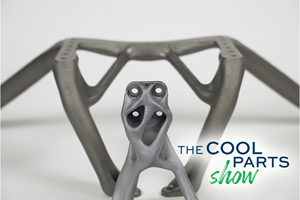How Exascale Computing Will Enable Born-Qualified AM Parts
ExaAM, a high-fidelity simulation tool, promises to reduce trial-and-error in additive manufacturing and help create metal 3D-printed parts that are qualified from the beginning.
The science of metal additive manufacturing (AM) today is focused on the quest for born-qualified parts: components that can roll off the print bed and be ready for direct use, including in critical structures like vehicles, airplanes and power plants. To accelerate the work, the Department of Energy’s (DOE) national laboratories are getting ready to apply one of the country’s biggest science tools to the task: exascale computing.
Researchers around the country have made tremendous progress in AM during recent years, particularly in the printing of large and geometrically complex objects from new materials, including metals, polymers, ceramics and even biomaterials, fulfilling the promise of fully customizable parts, lower production cost and less time-to-market for American manufacturers.
But printing a large, complex part that is structurally sound in every way requires a massive number of calculations, taking into account all the physics of each specific material in every step of the process, from feedstock compounding to melting to extruding and re-solidification of each layer.
Today much of that work is being done through trial and error. You model a part, choose materials, approximate how the physics will work, print it, test it, figure out what worked and what didn’t, and start all over again, each time making adjustments such as electron beam current, laser power, or scanning patterns. “Additive manufacturing provides accurate control of many aspects of the process, but it can be extremely time-consuming to find the optimal settings, particularly for complex parts,” says John Turner, leader of the Computational Engineering & Energy Sciences Group at Oak Ridge National Laboratory (ORNL). “If, on the other hand, you perform some of that trial and error virtually, then you’ll need fewer experiments.”
“When you get to the point in AM when you want to quickly produce custom parts for a wide range of applications, you don’t have a lot of time for trial and error,” notes Suresh Babu, the University of Tennessee/ORNL Governor’s Chair of Advanced Manufacturing. “One way to solve it is to try monitor everything with sensors. But the problem is you can’t measure everything that’s buried in the printed object without actually pulling it apart.”
Modeling Enabled by Exascale Computing
So, AM researchers rely on computational modeling to account for the effects of phenomena like thermal gradients and fluid dynamics on material behavior. These phenomena are controlled by the laws of physics, which can be described by equations. The equations have to be solved across different length and time scales, from microns to meters and from microseconds to hours. “That is not easy and it’s why we need supercomputers,” Babu says.
Enter exascale computing. Exascale stands to deliver the most advanced simulations and artificial intelligence (AI) capabilities ever known, with systems 50 to 100 times more powerful than most of today’s fastest supercomputers, capable of performing more than a billion billion calculations per second. DOE is working to meet the goal of launching a U.S. exascale system by 2021. The system, known as Frontier, will be sited at ORNL.
ORNL is already home to Summit, the world’s most powerful supercomputer launched in June 2018. Summit is a 200-petaflop machine, performing 200 quadrillion (peta-) floating point operations per second (flops). If every person on Earth completed one calculation per second, it would take 305 days to do what Summit can do in 1 second. For some AI applications, researchers can use less precise calculations than flops, potentially quadrupling Summit’s performance to exascale levels.
Obviously, manufacturers cannot afford their own supercomputers. But these big machines are DOE Office of Science user facilities, so their processing power can be accessed by researchers at universities and other institutions as well as through industry collaborations. Their power can be leveraged to create vastly improved simulations of the AM process, which can reduce trial and error and save energy and resources, as well as lead to new energy systems—one of the key missions of DOE.
To prepare for next generation supercomputers, scientists at the national laboratories are working with industry and academia to prepare new methodologies to link physics at different length and time scales, deploy them within applications and software within the emerging hardware relevant to DOE’s Exascale Computing Project (ECP). Turner is leading one project funded by ECP of particular interest to the additive manufacturing industry, “Transforming Additive Manufacturing through Exascale Simulation” or ExaAM, a collaboration between ORNL, Lawrence Livermore National Laboratory, Los Alamos National Laboratory and The National Institute of Standards and Technology (NIST).
ExaAM: A Simulator to Create Born-Qualified Parts from Metal Alloys
The goal of ExaAM is to develop an AM simulator that will give researchers a tool to determine the best method to print parts with complex geometries and site-specific properties, complemented by real-time, in situ process visualization, analyses and optimization. Coupled with a modern computer-aided design tool, the simulator will allow the routine use of AM to build unique, qualifiable metal alloy parts across many industries relevant to DOE.
In a sense, scientists are not only working to replicate thousands of years of cumulative knowledge of the casting, welding and forging processes, they are also researching new materials and compounds and how to best engineer their properties and behavior at the molecular level for a desired result.
“We may be missing out on opportunities if we don’t fully understand the fundamental physics,” Babu says. “We want to get to the point where we know that a certain material will have a certain kind of gradient and that the process will result in a specific type of surface, mechanical and functional properties. That requires a very fine scale of predictive power. Industry cannot do this themselves. This kind of science requires a consistent investment.”
“Today when we design a part and print it, we’re using approximations of the physics involved. But what exascale can do is remove as many of these approximations as possible.”
Turner notes that “there are parts of the AM process that are not well understood. There are effects that don’t happen in other processes like welding. Today when we design a part and print it, we’re using approximations of the physics involved. But what exascale can do is remove as many of these approximations as possible. If we can use these big machines to perform a more fully physics-accurate simulation, we can provide insight into these dark areas and create better parts.”
“We’ve already made tremendous strides in the deposition of materials, process visualization, in situ monitoring of the printing process, data science and the application of artificial intelligence tools for additive manufacturing. With exascale computing, we can take the work a step further and create more precise simulations that are informed by both part geometry and in-situ process measurements. The result will be to reduce the time for qualification of mission-critical components,” says Bill Peter, who directs the Manufacturing Demonstration Facility at ORNL, a DOE Office of Energy Efficiency and Renewable Energy (EERE) user facility devoted to AM research.
In materials science, researchers refer to a central framework: process, structure, properties and performance, Turner notes. Applying that to AM, “the process is all the things that go into making the part: the feedstock material, the beam diameter, all the knobs you can turn on the machine. They come together in the melting and solidification process to create a microstructure. That microstructure—the size of the grains, how they’re oriented—determines the properties.” Performance is how the resulting structure will perform in an actual application; there might be creep aspects or fatigue when the part is undergoing cyclic loading, for instance.
“What we’re striving for is a software environment that will allow you to simulate the entire process, tweaking all those parameters to get the performance you want in the end.”
NIST has been developing test methods and protocols, as well as requirements to reduce the cost and time to qualify AM materials, processes and parts. The ExaAM partners are creating experiments that are well suited to testing and refining the simulations being developed under the project.
That gets to one of the key takeaways from ExaAM, the scientists noted. Industry research in the qualification area is often considered proprietary by the companies involved. However, much of the ExaAM project will be published in open literature and available as open tools.
“What we’re striving for is a software environment that will allow you to simulate the entire process, tweaking all those parameters to get the performance you want in the end,” Turner says. ExaAM would not just calculate a single factor of physics and scale it up for the part. It would run one calculation that spawns other calculations and those eventual hundreds of thousands of calculations will be integrated to form a more accurate model.
While AM researchers are already developing simulations, their approach has been to simplify the physics and still create a good model. “Our approach is different,” Turner emphasizes. “We want the highest fidelity solution that is on par with actually performing an experiment. We want to reduce the number of trial-and-error steps and also enable the creation of better reduced-order models.”
“We can give validation of a part’s credibility if we can show how we built it knowing all the physics.”
“We can give validation of a part’s credibility if we can show how we built it knowing all the physics,” Babu says. “I strongly believe we are developing the foundational work to meet that goal.”
The DOE EERE’s Advanced Manufacturing Office (AMO) supports early-stage research to advance innovation in U.S. manufacturing and promote American economic growth and energy security.
ORNL is managed by UT-Battelle for the Department of Energy's Office of Science, the single largest supporter of basic research in the physical sciences in the United States. DOE’s Office of Science is working to address some of the most pressing challenges of our time. For more information, visit science.energy.gov.
About the Author
Stephanie Seay
Stephanie Seay is a science writer at Oak Ridge National Laboratory. Prior to her time at the lab, she was senior editor covering the North American energy industry at S&P Global.
Related Content
3D Printed Cutting Tool for Large Transmission Part: The Cool Parts Show Bonus
A boring tool that was once 30 kg challenged the performance of the machining center using it. The replacement tool is 11.5 kg, and more efficient as well, thanks to generative design.
Read MoreHybrid Additive Manufacturing Improves Debarking Knife Tip Strength and Production Efficiency
Nicholson Manufacturing chose the Mastercam APlus specialized add-on to unlock hybrid manufacturing for making its debarker knife tips, enabling it to add durable layers to the wear surfaces of the tips to make them more resilient while also making the production process more efficient.
Read More7 Things We Saw at Formnext 2024 — Video Playlist
There were countless processes, applications and announcements at Formnext 2024. Here are seven standouts Peter Zelinski and Stephanie Hendrixson caught on film.
Read More3D Printed "Evolved Structures" for NASA Exoplanet Balloon Mission: The Cool Parts Show #61
Generative design creates stiff, lightweight brackets for EXCITE mission monitoring planets orbiting other stars. The Cool Parts Show visits Goddard Space Flight Center.
Read MoreRead Next
Postprocessing Steps and Costs for Metal 3D Printing
When your metal part is done 3D printing, you just pull it out of the machine and start using it, right? Not exactly.
Read More3D Printed Polymer EOAT Increases Safety of Cobots
Contract manufacturer Anubis 3D applies polymer 3D printing processes to manufacture cobot tooling that is lightweight, smooth and safer for human interaction.
Read MoreCrushable Lattices: The Lightweight Structures That Will Protect an Interplanetary Payload
NASA uses laser powder bed fusion plus chemical etching to create the lattice forms engineered to keep Mars rocks safe during a crash landing on Earth.
Read More




















